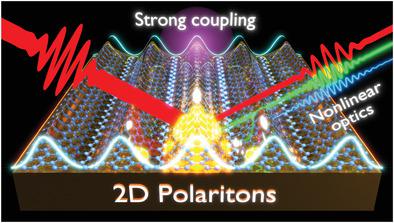当前位置:
X-MOL 学术
›
Adv. Opt. Mater.
›
论文详情
Our official English website, www.x-mol.net, welcomes your feedback! (Note: you will need to create a separate account there.)
Strong Light–Matter Interactions Enabled by Polaritons in Atomically Thin Materials
Advanced Optical Materials ( IF 9 ) Pub Date : 2020-01-14 , DOI: 10.1002/adom.201901473 P. A. D. Gonçalves 1, 2, 3 , Nicolas Stenger 1, 2 , Joel D. Cox 3, 4 , N. Asger Mortensen 2, 3, 4 , Sanshui Xiao 1, 2
Advanced Optical Materials ( IF 9 ) Pub Date : 2020-01-14 , DOI: 10.1002/adom.201901473 P. A. D. Gonçalves 1, 2, 3 , Nicolas Stenger 1, 2 , Joel D. Cox 3, 4 , N. Asger Mortensen 2, 3, 4 , Sanshui Xiao 1, 2
Affiliation

|
Polaritons, resulting from the hybridization of light with polarization charges formed at the boundaries between media with positive and negative dielectric response functions, can focus light into regions much smaller than its associated free‐space wavelength. This property is paramount for a plethora of applications in nanophotonics, ranging from biological sensing to photocatalysis to nonlinear and quantum optics. In the two‐dimensional (2D) limit, represented by atomically thin and van der Waals (vdW) materials of single‐layers bound by weak vdW attraction, polaritons are characterized by extremely small wavelengths associated with extreme optical confinement, and furthermore can exhibit long lifetimes, electrical tunability, and extreme sensitivity to their dielectric environment, among many other desirable qualities in nano‐optical device applications. Here, the fundamentals of polaritons in atomically thin materials are summarized, emphasizing plasmon and exciton polaritons, their strong light–matter interactions, and nonlinear plasmonics. More specifically, this review opens with a pedagogical discussion of plasmons in extended and nanostructured graphene, providing a classical electrodynamical model in a nonretarded theoretical framework, and the ultraconfined acoustic plasmons supported by hybrid graphene–dielectric–metal structures. In addition, the basic principles are introduced and the recent developments on nonlinear graphene plasmonics and on strong coupling physics with atomically thin transition metal dichalcogenides are reviewed. Finally, potentially new, promising research directions in the burgeoning field of 2D nanophotonics are identified.
中文翻译:

原子薄材料中的极化子引起的强光物质相互作用
光与在具有正和负介电响应功能的介质之间的边界处形成的极化电荷混合产生的极化子可以将光聚焦到比其相关自由空间波长小得多的区域。对于从生物传感到光催化再到非线性光学和量子光学的纳米光子学中的大量应用,此特性至关重要。在二维(2D)极限中,以受弱vdW吸引力约束的单层原子薄和范德华(vdW)材料为代表,极化子的特征在于与极小的光学限制相关的极小的波长,并且可以表现出较长的波长寿命,电气可调性以及对其介电环境的极度敏感性,纳米光学器件应用中的许多其他理想品质。这里,总结了原子薄材料中极化子的基本原理,重点介绍了等离激元和激子极化子,它们的强光-物质相互作用以及非线性等离激元。更具体地说,本篇综述以扩展性和纳米结构石墨烯中的等离激元的教学法讨论为开端,在不延迟的理论框架中提供了经典的电动力学模型,以及由混合石墨烯-介电金属结构支撑的超限声等离激元。此外,介绍了基本原理,并综述了非线性石墨烯等离子体激元和与原子稀过渡金属二卤化物强耦合物理的最新进展。最后,可能是新的
更新日期:2020-03-05
中文翻译:

原子薄材料中的极化子引起的强光物质相互作用
光与在具有正和负介电响应功能的介质之间的边界处形成的极化电荷混合产生的极化子可以将光聚焦到比其相关自由空间波长小得多的区域。对于从生物传感到光催化再到非线性光学和量子光学的纳米光子学中的大量应用,此特性至关重要。在二维(2D)极限中,以受弱vdW吸引力约束的单层原子薄和范德华(vdW)材料为代表,极化子的特征在于与极小的光学限制相关的极小的波长,并且可以表现出较长的波长寿命,电气可调性以及对其介电环境的极度敏感性,纳米光学器件应用中的许多其他理想品质。这里,总结了原子薄材料中极化子的基本原理,重点介绍了等离激元和激子极化子,它们的强光-物质相互作用以及非线性等离激元。更具体地说,本篇综述以扩展性和纳米结构石墨烯中的等离激元的教学法讨论为开端,在不延迟的理论框架中提供了经典的电动力学模型,以及由混合石墨烯-介电金属结构支撑的超限声等离激元。此外,介绍了基本原理,并综述了非线性石墨烯等离子体激元和与原子稀过渡金属二卤化物强耦合物理的最新进展。最后,可能是新的

























 京公网安备 11010802027423号
京公网安备 11010802027423号